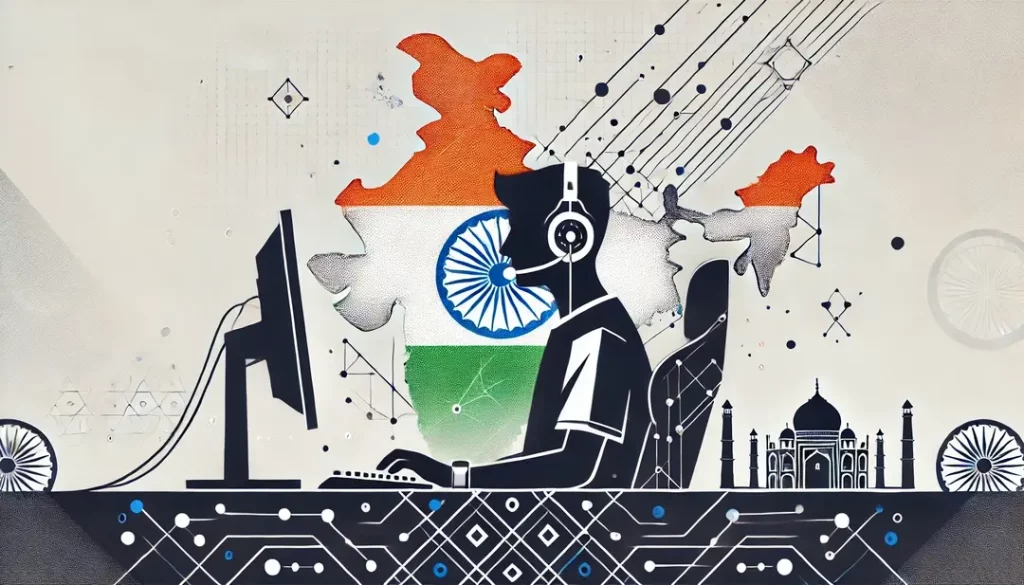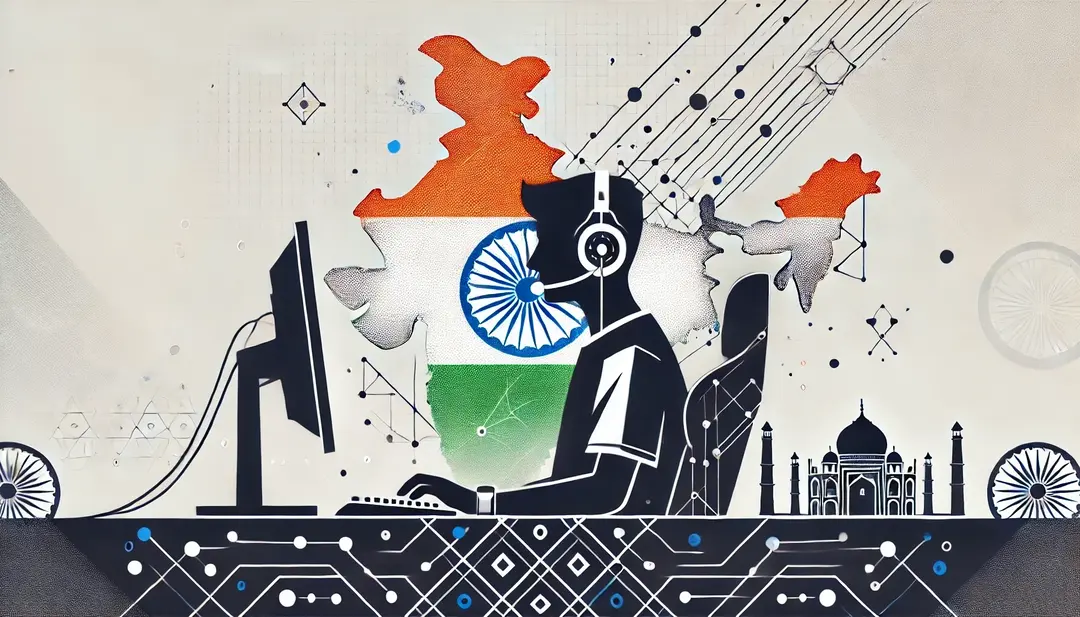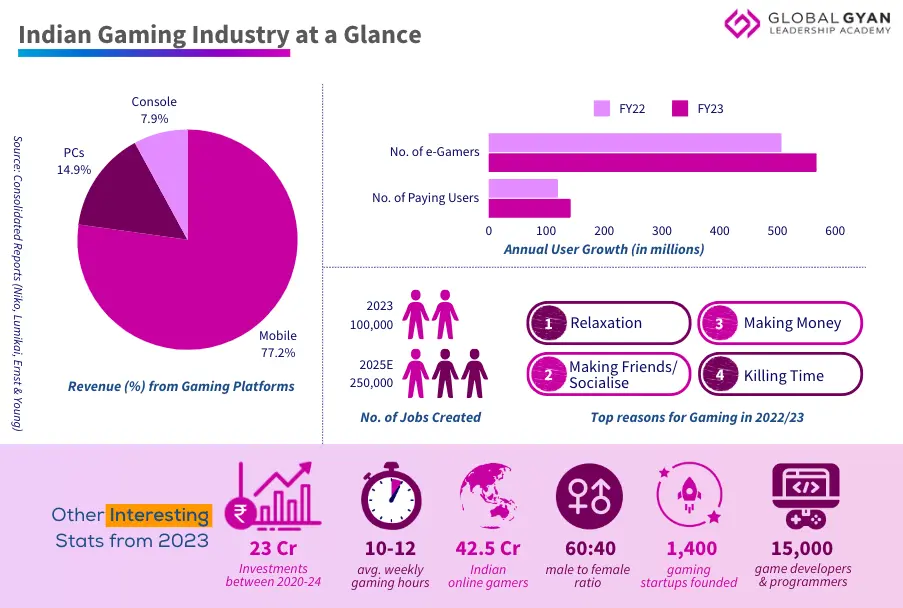From Game Rooms to Bank Rolls: The Big Money Boom in Indian Esports


Riyanna (not her real name) is a 20-something-year-old online gamer. She has a YouTube account with over half a million followers. She wakes up early in the morning and exercises for half an hour. After breakfast, she sets up her PC and starts planning what game(s) she wants to play and stream for her followers. In the day, she performs basic data analytics on her past videos to determine what ticks with her audience, and depending on that, selects which game to play and record. While playing, Riyanna typically likes to chill with her online friends and interact with her followers. She often collaborates with her gaming peers to partake in gaming tournaments and reviews new games in the market—for both, she is handsomely rewarded. After dinner, she sits down once again to plan the next day.
Riyanna is your average game influencer who has taken the esports world by storm in India.
Minecraft, PUBG, Fortnite, League of Legends, Counter Strike, DOTA, Dungeons and Dragons, Call of Duty, GTA… Today, you’d find only a few neanderthals around the world who haven’t played these games, and much less those who haven’t heard of them.
The Indian e-gaming industry is a goldmine. As per the State of India Gaming Report 2023, the industry clocked a whopping $3.1B and is set to touch $7.5B by FY28! That is a formidable CAGR growth of 20%. The report states that India houses close to 568 million gamers, out of which 25% are those who outright purchase games. Now that is an egregious figure for a nation that typically gauges every dime it spends. These folks would spend anywhere between 10-12 hours on average every week playing competitive games on their mobiles, PCs & consoles. For the sake of this article, we will solely focus on this niche.

And here’s another factoid for you – India boasts 1,000 gaming studios, 1.8 million esports players and 22 professional esports teams. Local gaming companies like Dream11 & Games2win and streaming platforms like Loco and Rooter have become major proponents of growth for esports, or competitive sports, so much so that they’re giving global competitors like Twitch and Steam a run for their money. Couple this with the friendly government policies, you’re looking at a sector that is on the precipice of world dominance.
India’s online gaming segment is experiencing remarkable growth, indicating substantial economic potential. With a robust gaming community consisting of 42.5 crore gamers—second globally after China—the sector has potential to accelerate Foreign Direct Investment inflows, job creation, and investments across various sectors.
But wait, who and what has caused this hyperbolic rise? Is this a blip in the system, much like everything else the corporate world has witnessed since COVID-19? If not, then what’s in store for the segment in the future? How can government policies complement this majestic boom? Let’s break it down.
Who is the Target Group?
According to several credible reports, the primary audience for esports in India is predominantly young adults aged between 18 and 30 years. This demographic, often referred to as digital natives, is not only tech-savvy but also passionate about gaming, online and offline alike. Gen-Zs have grown up with technology at their fingertips, making them naturally inclined towards digital entertainment, such as streaming media apps and mobile games, that are not only ubiquitous but also less moderated.
Esports in particular, with its league/tournament-like format, has attracted many young adults for the simple reason that the competitive nature of these games provides an adrenaline rush that is similar to traditional sports. Additionally, the thrill of gaming offers an engaging and immersive experience. Several online gamers have also shared that they’ve formed lasting virtual bonds with fellow gamers based on mutual interest and shared experiences, creating a sense of community and belonging.
The accessibility of esports has played a crucial role in its burgeoning popularity among the youth. With affordable smartphones and widespread internet connectivity, young adults can easily participate in or follow esports events from anywhere. For this reason, the esports sector has quietly penetrated the older demographic as well. Where traditionally this group viewed gaming as a pastime primarily for the youth, a growing awareness and acceptance of gaming as a legitimate form of entertainment and even a professional pursuit has caused more adults to begin engaging with esports.
Virtual gaming is no longer an expensive hobby for urban youth who can afford it. Interest in esports is expanding beyond metropolitan areas, covering Tier 2 and Tier 3 cities as well.
With such a broad target audience, esports are sure to leave a lasting impact. Many gamers have credited the domain with strengthening their critical thinking and problem-solving skills. Gamers adopt different strategies to beat levels and advance in games. It also helps foster a healthy competitive spirit among the gaming community. A good bonus is that there are big prizes to be won. Companies and organisers are also recognising this potential, customising content and marketing strategies to cater to these evolving demands.
Rising Stakes Make for Attractive Careers
The allure of high stakes and substantial prize money in esports tournaments in India is drawing a growing number of youngsters to consider gaming as a full-time career. Major esports tournaments, such as the India Gaming Show, ESL India Premiership and the Battlegrounds Mobile India Series, offer prize pools that run into crores of rupees. This significant financial incentive is a primary driver for aspiring gamers who see esports as not just a passion but a viable profession.
For instance, the Battlegrounds Mobile India Series boasts of prize pools in the ballpark of ₹2 crore, attracting thousands of participants from across the country. Such lucrative rewards have turned the heads of many young gamers who are eager to showcase their skills on a competitive platform. Winning or even playing in these tournaments can lead to significant financial gains, providing a strong foundation for a professional gaming career.
As of the year 2023, the overall prize money awarded at eSports events held across India amounted to 181 million Indian rupees.
Beyond direct winnings, successful esports players also have opportunities to earn through sponsorships, endorsements and streaming revenues. Brands are keen to partner with popular gamers, further boosting their income. This financial potential, combined with the excitement of competition and the possibility of fame, makes esports a highly attractive career option for India’s youth.
Fierce Competition for a Big Chunk of the Pie
The growing potential for esports in India has caught the attention of major business houses and established players in the industry. Companies like Reliance Jio and Paytm have already made significant investments in this space, recognising the growing popularity of the domain among the Indian youth. Reliance Jio, for instance, launched JioGames in tandem with its extensive digital infrastructure to promote and support esports events. In 2023, JioCinema partnered with South-Korean gaming behemoth Krafton (creator of PUBG and BGMI) to stream India’s biggest esports event Battleground Mobile India Series (BGIS).
Similarly, Paytm has ventured into esports through its gaming platform, Paytm First Games, which hosts various tournaments and competitions through a strategic partnership with leading esports tournament platform & network Esports Players League (ESPL). This move not only harnesses the expanding esports market but also aligns with the company’s broader strategy of creating a comprehensive digital ecosystem. Established gaming companies like Nazara Technologies are also expanding their portfolios to include more esports titles and tournaments, further fuelling the growth of the industry.
As of 2024, there are 1,718 gaming startups in India, with the number predicated to grow at an astronomical rate. However, this also means more competition and bigger stakes. One thing’s for certain, as competition intensifies, innovation and quality will become crucial differentiators. Businesses will strive to provide the best gaming experiences and platforms, fostering a competitive yet collaborative environment. Additionally, the influx of investment from major business houses will likely lead to improved infrastructure, higher prize pools and better training facilities for esports athletes.
Playing the Long Game: A Government Perspective
For any industry to excel and thrive, it warrants massive support from the government. To this end, the newly-formed Indian government has taken an empathetic stand towards esports. In fact, very recently, Prime Minister Shri Narendra Modi met with some of the country’s leading gamers to understand the nature of the domain and was quoted saying, “It (esports and gaming) does not require any regulation. It must remain free, only then it will boom”. While we applaud the sentiment, we can’t help but wonder whether the pressure to regulate the sector may eventually catch-up with the government.
One of the most significant moves which has given the sector a much-needed push is the inclusion of esports in the Khelo India initiative by the Ministry of Youth Affairs and Sports. This initiative aims to promote and support various sports across the country and bolsters its rising importance and legitimacy. State governments are also playing a crucial role here. For instance, Karnataka and Maharashtra have hosted several esports events, indicating a regional push to promote this industry. These events not only provide a platform for young talent but also help in raising awareness and acceptance of esports as a viable career option.
However, despite these positive steps, a comprehensive national policy specifically tailored for esports is still lacking. There is a need for clearer regulations and structured support to ensure sustainable growth. This includes aspects like player rights, fair play, anti-doping regulations and intellectual property protections for game developers. Funding support is also crucial. While private investments are increasing, government-backed funding and incentives could significantly boost infrastructure development and talent nurturing. Collaborative efforts between government bodies and private entities will be essential to create a robust ecosystem for esports in India.
Show Me the Money!
With the domain’s growing popularity in India, gaming start-ups have attracted significant funding from venture capitalists and private equity firms who are actively recognising the lucrative opportunities it presents. In terms of app downloads, India is the world’s largest mobile gaming market as of 2024. The industry as a whole has raised $2.8B in from domestic & global investments in the last five years and continues to aggressively expand its teeth. With three gaming unicorns (Game 24X7, Dream11 and Mobile Premier League) at the helm, the industry is poised to yield huge ROI for investors.
Private investments are coming from various quarters, including tech giants, media companies and established gaming firms. For instance, Nazara Technologies, a major player in the Indian gaming sector, has been actively investing in esports startups and platforms to expand its footprint and support the growth of the industry. Similarly, global investors are also entering the fray, providing the necessary financial backing to nurture and scale esports ventures.
These investments are being utilised to develop infrastructure, organise large-scale tournaments and create talent development programs for emerging esports athletes. Funding is also flowing into the creation of esports academies and training centres, which aim to nurture young talent and provide them with the skills needed to compete at national and international levels.
Additionally, sponsorship deals are becoming a significant source of funding for esports teams and events. Brands from various sectors, including technology, consumer goods and sports, are keen to associate with esports to reach the young and engaged audience.
What’s in it for Non-Gamers?
For those who like to call the shots behind the scenes, the esports boom in India has something in store for them as well. The sector has steadily created a plethora of job opportunities and promises growth prospects across various sectors. As the industry expands, it is opening up diverse career paths beyond just professional gaming. Roles such as game developers, graphic designers, event organisers, marketers and content creators are in high demand. The need for specialised skills in game design and development has led to the rise of dedicated training programs and courses in colleges and private institutes.
Esports teams and organisations are also hiring coaches, analysts and team managers to support professional players and help them grow. These roles are crucial in helping teams strategize and improve performance, similar to traditional sports teams. Moreover, the growth of esports streaming platforms has created opportunities for streamers and influencers who engage with large audiences and generate significant revenue through sponsorships and advertisements.
Event management is another burgeoning field within esports. Organising tournaments, both online and offline, requires a skilled workforce capable of handling logistics, marketing and production. This segment is expected to grow as more large-scale esports events are planned across the country.
Additionally, companies involved in esports are looking for professionals in sales, public relations, and customer support to enhance their services and reach. The increasing investment in esports is driving the demand for financial analysts and business development managers to navigate the commercial aspects of the industry.
Life of an E-Gamer: The Dark Side
Esports have unearthed exciting opportunities for Indians, but also pose potential health challenges for gamers who spend excessive hours in front of screens. According to credible reports, gamers often spend 10-12 hours per week engaged in gameplay, and many exceed these numbers, dedicating significant portions of their day to gaming. This prolonged screen time can have several detrimental effects on physical and mental health.
Physically, extended gaming sessions can lead to issues such as eye strain, headaches and poor posture, which can cause long-term problems like chronic back pain. The lack of physical activity also contributes to obesity and related health conditions. Mentally, excessive gaming can lead to sleep disturbances, anxiety and even gaming addiction, where the compulsion to play interferes with daily life and responsibilities.
Furthermore, the immersive nature of online gaming can lead to social isolation, as gamers may prioritise virtual interactions over real-world relationships. This isolation can exacerbate feelings of loneliness and depression. Gamers need to be mindful of these potential consequences and adopt healthy gaming habits. Taking regular breaks, engaging in physical activities, and balancing screen time with social interactions can help mitigate these risks and promote overall well-being.
Final Thoughts
The Indian e-gaming industry is a goldmine, one that promises massive returns for all stakeholders. It’s not just a trend waiting to catch up with its global counterpart; it is part of a transformative revolution that is reshaping the way Indians view entertainment—and the potential that remains unearthed. The industry is set to thrive; however, there are a few challenges it needs to overcome:
- Consistent Backing from the Government: Ensuring regular policy support and funding to boost infrastructure and provide legitimacy to esports.
The esports and video gaming sector in India is brimming with potential. We have a massive pool of talented gamers, but to truly compete globally, we need targeted support in the upcoming budget. This includes tax breaks for studios creating original esports and video gaming content, investment in infrastructure to foster development of high-quality games and initiatives to cultivate a skilled esports workforce.
– Rajan Navani, Chairman and President of the Indian Digital Gaming Society
- Attract Steady Foreign Investment: Encouraging international investors to fund esports ventures, enhancing financial growth and global exposure.
- Improve Game Quality: Developing and localising games to meet global standards, which will attract a broader audience and increase player retention.
- Fight the Stigma: Overcoming societal stereotypes, especially among older demographics, by promoting esports as a legitimate career and beneficial activity.
- Infrastructure Development: Building advanced gaming facilities and training centres to nurture talent and host international tournaments.
- Health Repercussions: Addressing potential health concerns, including physical strain and mental health issues, associated with prolonged gaming sessions.
The seeds for prosperity have been sown for the esports sector. Now, all that’s needed is water and sunshine to help it bloom to greater heights. And time is of the essence in this endeavour.






Responses